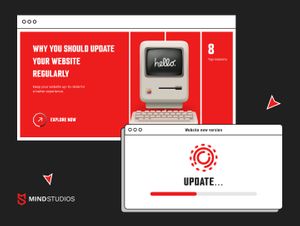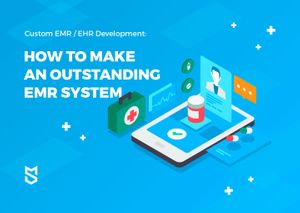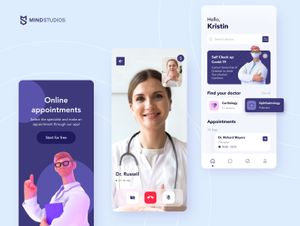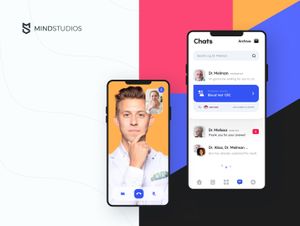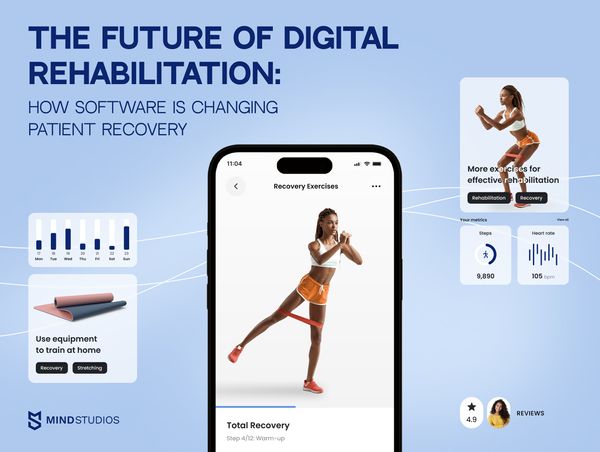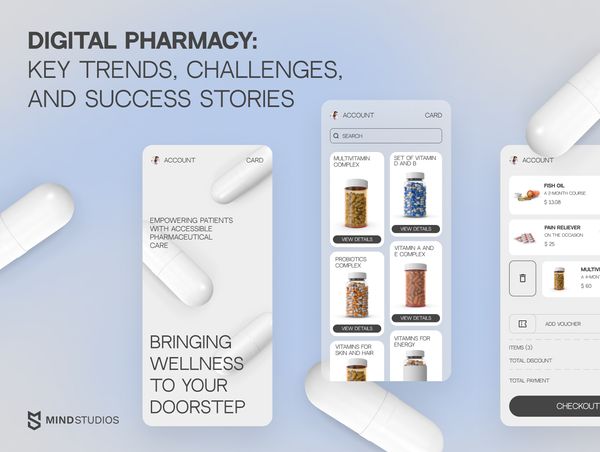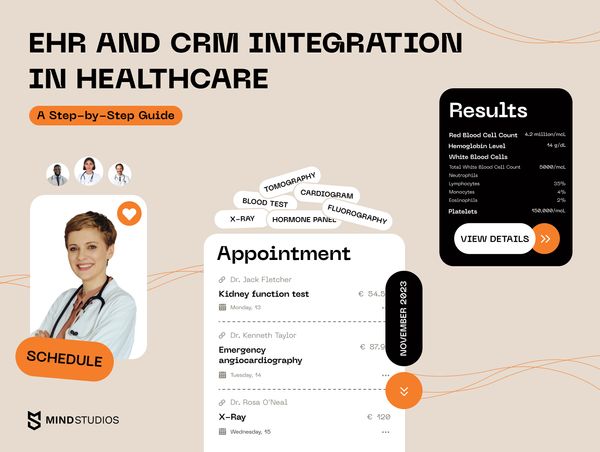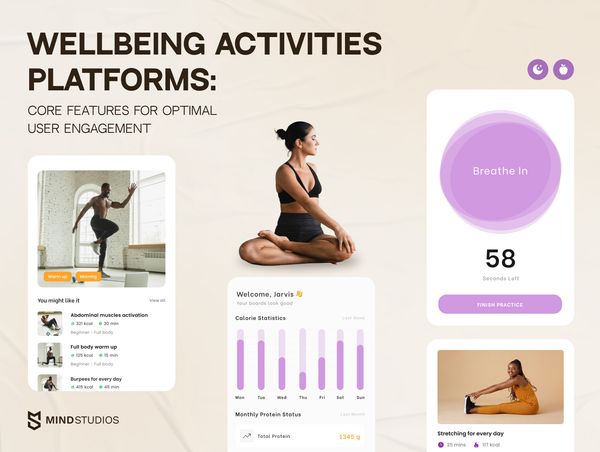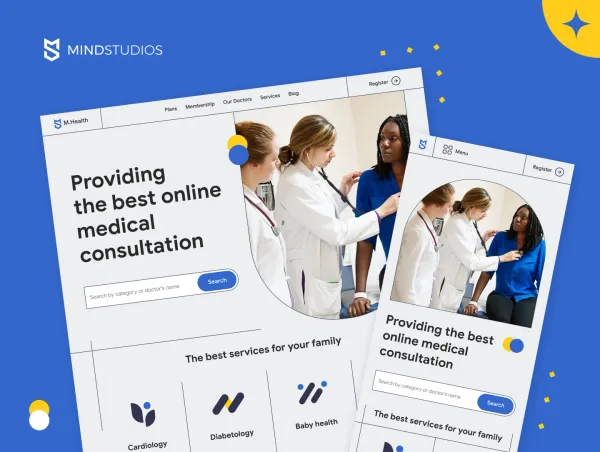
People seek medical assistance online when they can’t get it offline for any number of reasons. In the US, about 94% of young adults looked up health information online in 2020.
At the same time, only 20% of young adults connected with a health provider online. One of the reasons for that might be that the healthcare industry is lagging behind when it comes to digital transformation. This makes medical web development a sure way to get ahead of your competitors in the industry — there’s high demand here and the supply leaves much to be desired.
In this article, we’ll be talking about medical website design and development, its challenges, and its costs. We build our knowledge on massive research we’ve compiled while working on several health-related web and mobile projects. Read on to learn more about the processes involved in medical website development or scroll down to get a rough cost estimate.
Benefits of having an up-to-date medical website
There’s really no argument as to whether healthcare providers need websites — of course they do. A website is a good investment for any company these days. If you don’t have an online presence, it’s almost as if you don’t exist. And while one can argue about the truth of this statement when it comes to a personal Facebook page, when talking about growing a business, there’s really no second opinion.
Healthcare web development can bring a medical establishment numerous benefits:
- Greater accessibility. A website is more accessible than a call center — it doesn’t need as many employees, offers patients visual information, and has no phone queues. While you might still keep your call center for those who don’t use the internet for some reason, a website will significantly lessen the load on your employees.
- New opportunities for marketing. Your clinic can be found online, which is exactly where people look up everything these days. With professional search engine optimization and a solid medical information database on your website, people who aren’t your patients will be able to easily find your clinic.
- You can offer all information about your clinic in one place. This includes information on the doctors you employ, their credentials, services your clinic can provide, etc.
This list is just the tip of the iceberg, but these benefits alone would be reason enough to build a great website and an app for your clinic. And that was before COVID-19.
As the pandemic showed us, online access to healthcare has become one of the most needed services. This has been the final push towards digitization for many businesses, but for healthcare providers, the COVID-19 impact was so enormous it’s still hard to comprehend.
From here on out, the digitization of healthcare will likely go way faster, and no clinic can afford to lag behind.
Who needs medical websites: Main medical website tasks
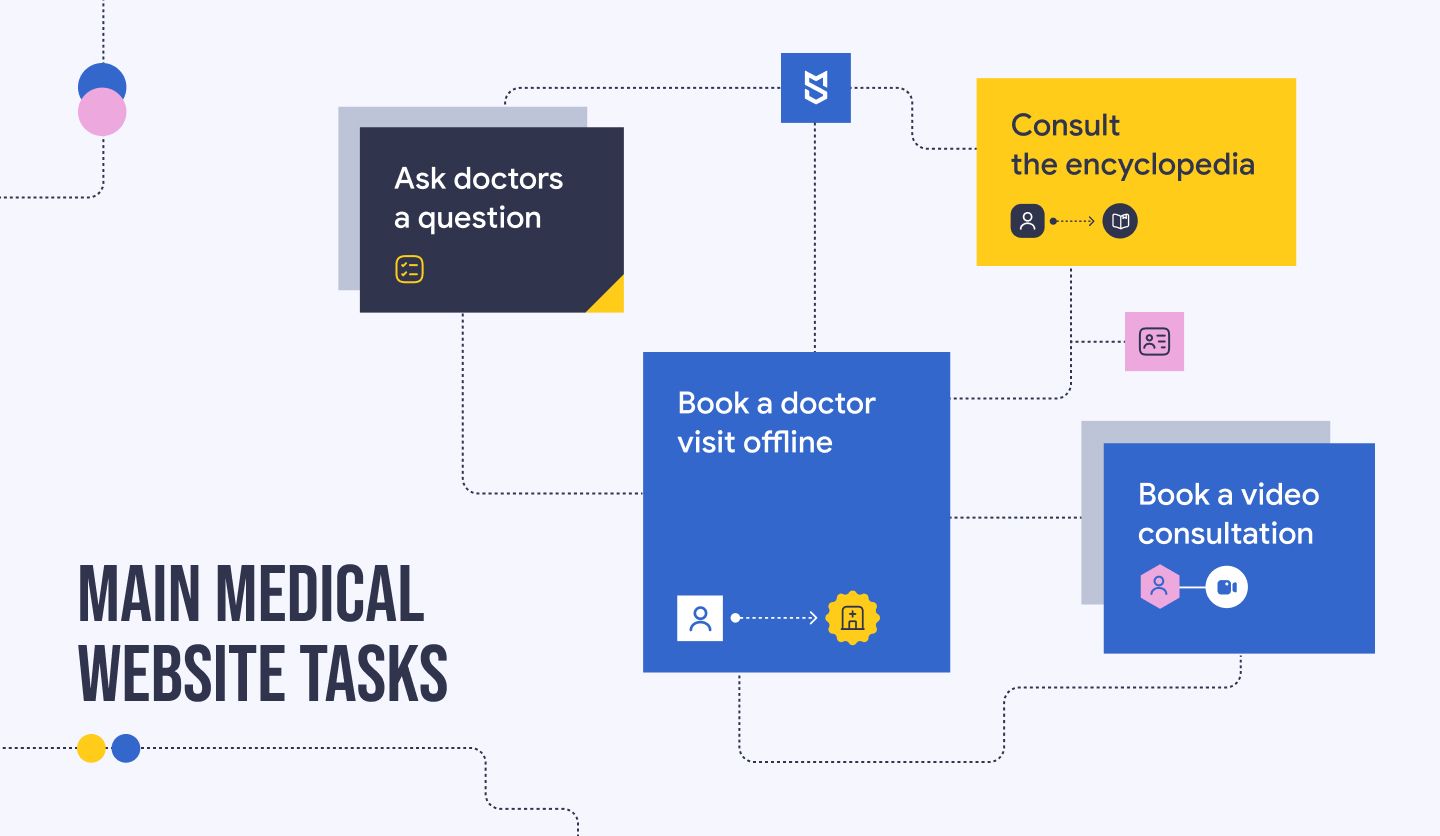
Besides the accessibility and marketing needs we’ve outlined above, there are other tasks that your medical establishment — a clinic, a hospital, a lab, or a doctor’s personal practice — can perform better if you develop a healthcare website. Here, we’d like to outline some of them.
Means for doctor-patient communication
A web portal for a clinic can provide not just a phone number patients will call to schedule a visit to a doctor. You can also implement a chat and/or means for scheduled video calls with the doctor. This will eliminate the need for at least a portion of personal visits and enhance the experience for busy patients.
Means for automation of certain features
A chatbot can be even more efficient than a human employee when it comes to some actions. For example, a machine-powered helper will make fewer mistakes like mishearing the date and time a patient wants an appointment made. A bot can also help patients renew or order a prescription.
An online form can be used to ask non-urgent questions — doctors will later look through them and answer. With proper design and sorting feature, no form will be accidentally misplaced.
All this will free time for your employees to complete the administrative functions robots can’t yet perform.
Means for education
Having a health portal of sorts is a big win for a medical establishment. You can post scientifically supported health information so that patients can have a reliable source instead of trusting search engines and social networks.
At the same time, a health portal for doctors’ access can be used to build a database of clinical decisions for future reference. This will surely be of help in many cases, shortening the time to treat patients.
Trends in the medical industry
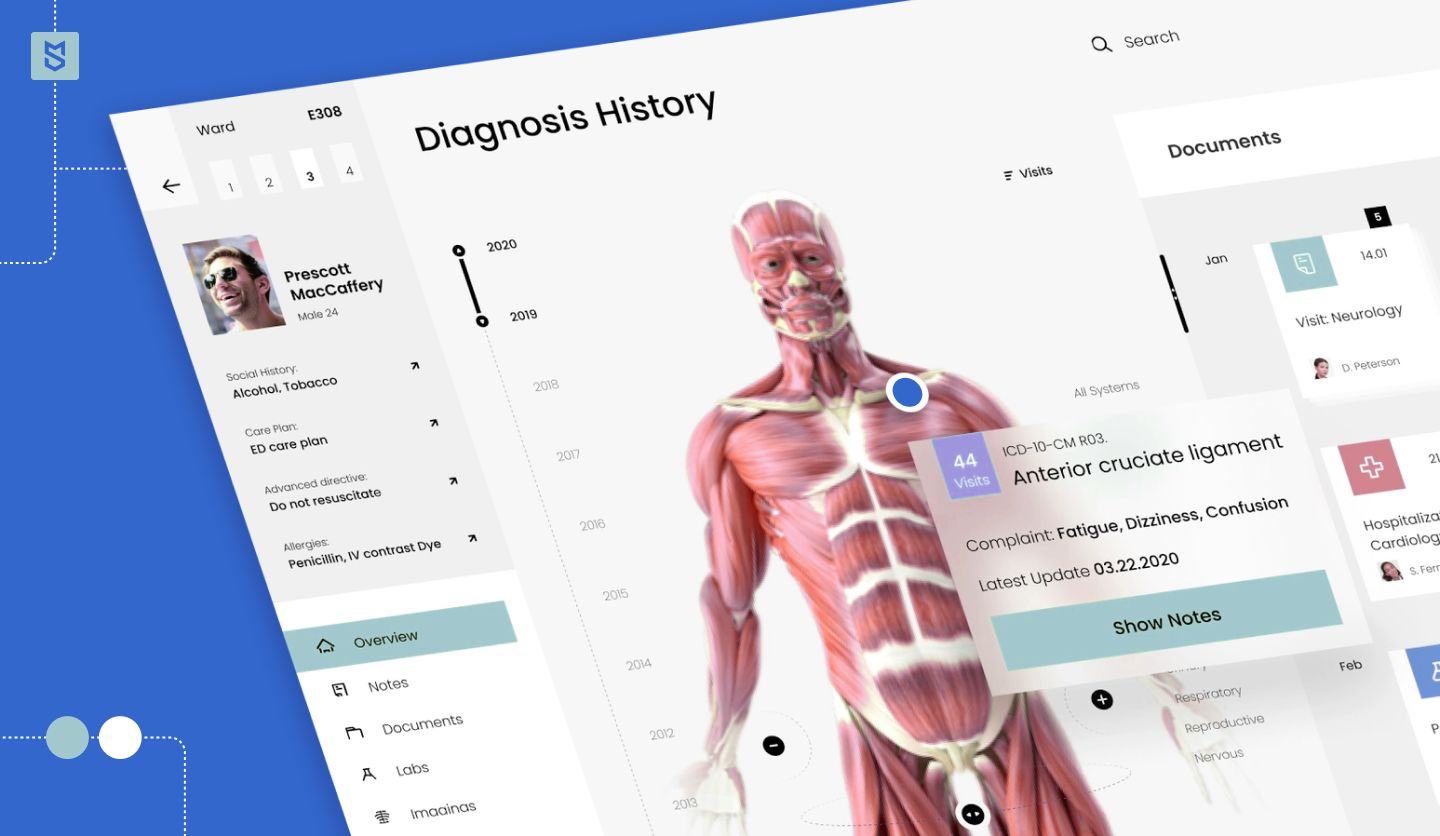
Modern technology is a blessing for humanity. It not only allows us to travel far and enjoy never before seen conveniences; it also lets us live twice as long as people did just a couple hundred years ago. Technology has brought us better medicine and cures for previously deadly ailments.
So what trends dominate the modern healthcare industry?
Artificial intelligence
AI is everywhere these days, and healthcare industry is no exception. In medical website development, you can use AI to enhance user experience with the help of machine learning. The benefits of AI in healthcare extend to both patients and professionals. An AI-powered website will provide users information related to their previous inquiries, offer subscription renewals on time; it can also be of help to doctors as a so-called “augmented intelligence”.
By the way, not so long ago we wrote a more detailed post about what options for using AI/ML in healthcare exist.
EHR/EMR
Whether it’s the general complexity of transferring loads of data from paper to the screen or government-imposed bureaucracy, the medical industry has a long way to go when it comes to digitizing. But the process has been launched. Electronic health record/electronic medical record (EHR/EMR) systems are being adopted by more and more hospitals and clinics.
EHR/EMR systems allow healthcare providers to keep records of patients’ medical information.
Telemedicine
Telemedicine is among the top 20 trending ideas for software development in 2022. Telemedicine is a field aimed at providing healthcare services remotely, complete with scheduling, consultations, and prescriptions. Creating a telemedicine platform is somewhat comparable to developing an online medical website but has its peculiarities.
Corporate healthcare
More and more companies worldwide set up contracts with healthcare providers to offer employees coverage for healthcare services as a benefit. Having an offer of corporate healthcare on a clinic website can be a big win and set your establishment apart.
HIPAA, HITECH, GDPR (and other scary abbreviations)
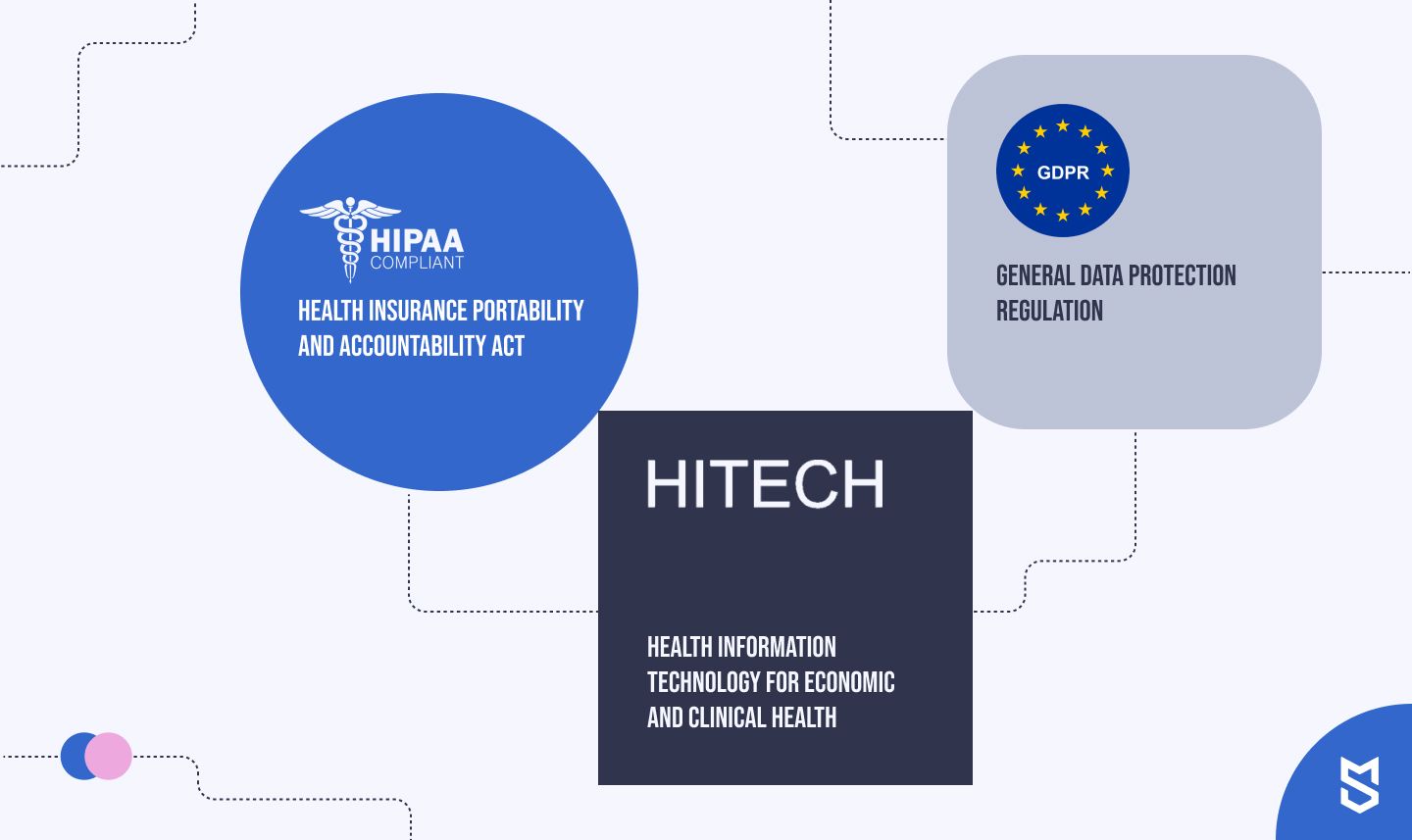
The following is some information you need to take into consideration when developing a healthcare website. Healthcare websites are subject to specific laws, and hospital website development is no trifle.
Medical information is extremely important and is considered sensitive in most countries. Hence, when storing medical records online, measures must be taken to protect them. For this reason, there are guidelines for data security.
In the US, the two main laws aimed at protecting medical data are the Health Insurance Portability and Accountability Act (HIPAA) and the Health Information Technology for Economic and Clinical Health (HITECH) Act.
To adhere to HIPAA and HITECH, any health organization operating on US territory must provide the means to thoroughly protect patients’ personal data at all levels, online and offline. For websites, this means:
- being SSL certified and encrypting data with the latest technology available
- using only a HIPAA-compliant hosting provider
- having data backups
- notifying patients of how their personal information is stored and used via a privacy policy
Complying with HIPAA and HITECH for software development is a legal requirement but also improves your reputation. Failure to comply with HIPAA and HITECH requirements can result in considerable fees and, if continued, may lead to lawsuits and to authorities revoking your license.
Since 2018, Europe has had similar requirements in place in the form of the General Data Protection Regulation, or GDPR. The GDPR concerns not only health-related platforms but any websites dealing with users’ data.
Depending on where you’re launching your medical website, you’ll need to check local legislation concerning medical and personal data.
Define tech stack for your healthcare website
Websites for healthcare providers vary greatly, and much of the technology used will depend heavily on the exact list of features you’ll wish to implement and on the healthcare website developers you’ll partner with.
Our developers have gathered the technology they use when working with healthcare projects. Check out the table below if you’d like to acquaint yourself with an example.
| Front-end | JavaScript, HTML, CSS, Vue.js, React.js, Bootstrap, Highcharts |
| Backend | Ruby on Rails, Elixir/Phoenix, Node.js, Sidekiq |
| Sign-up/sign-in | Facebook API, Google API, Amazon SES | Data storage | Amazon S3, Google Cloud Storage |
| Databases | MySQL, PostgreSQL, MongoDB, Redis |
| Scheduling | Google Calendar API |
| Notifications | Twilio |
| Video calls | WebRTC, RTMP |
| Chat | Firebase, Twilio |
| Payments | PayPal, Stripe |
| Video/audio playback | AWS Lambda, FFMpeg, m3u streams |
Medical website design
A website is as much the face of your company as your clinic itself, and even more so in some regards. That’s why it’s important to approach your website’s design with dedication and care. Design trends change rather frequently, and it’s recommended to revisit and update your website regularly with the help of medical web design specialists. If you want to choose the best medical web design for your website, here is information on the current trends in healthcare website design.
Minimalism and bright colors
Your website needs to be made in your corporate colors to be instantly associated with your clinic. Today, bright colors are preferred for healthcare platforms as they alleviate fears and brighten the mood.
Clean health web design and easy navigation
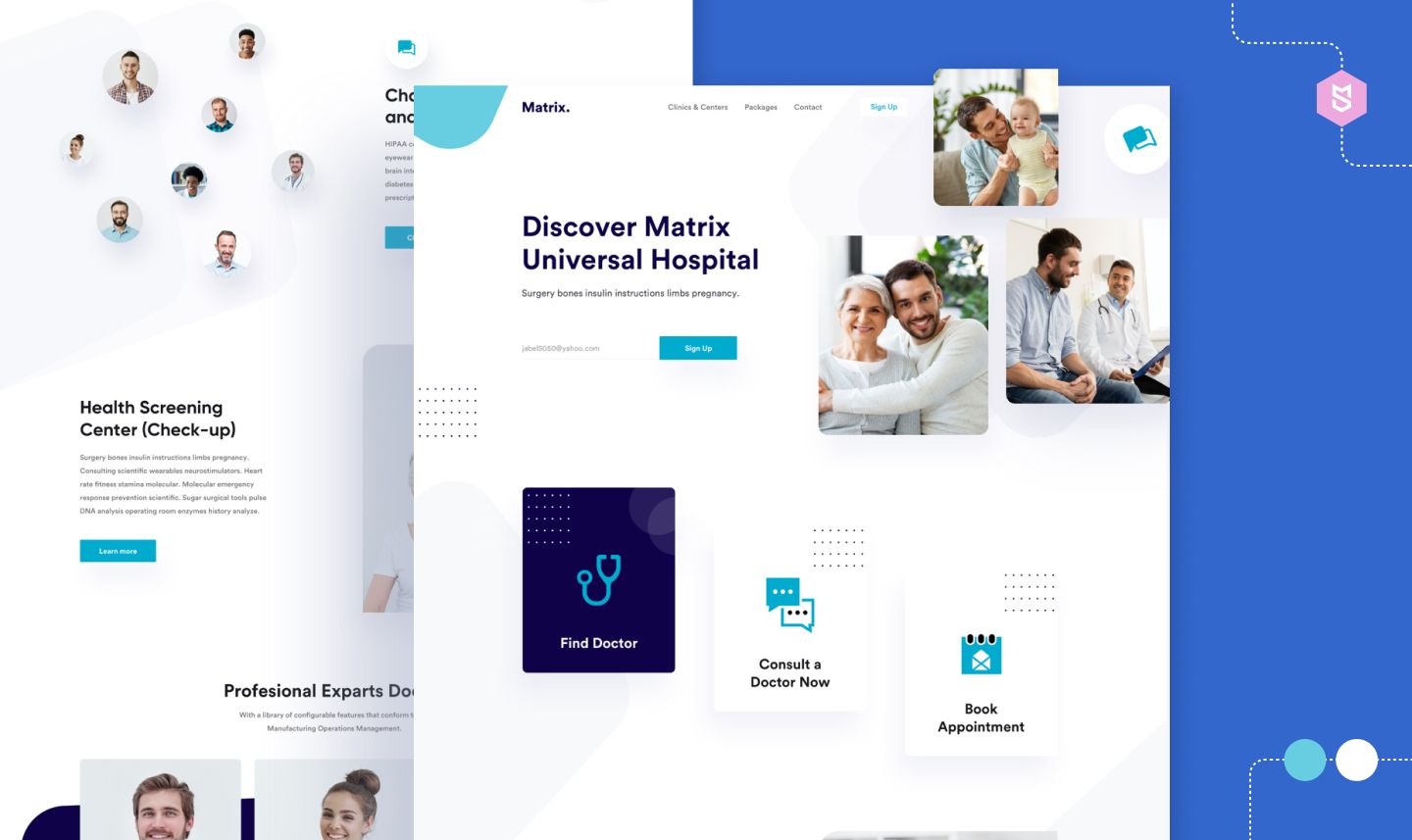
Minimalist and clean medical clinic website design is a trend even outside of healthcare. Marie Kondo your website and make the important parts stand out by eliminating redundant information or rearranging the pages so they’re easier to view.
If you make your website design simple and intuitive, your patients will spend less time looking for what they need, which will improve the user experience and user satisfaction. With high user satisfaction, first-time visitors will turn into regular patients.
Accessibility
Web design accessibility is about making websites easier to use for individuals with disabilities. For clinic websites, this is even more important than for other websites. When it comes to websites, accessibility features usually target users with vision impairments and physical limitations, although measures can be taken to help people facing other challenges as well.
Some websites have a separate version of pages created specifically for people with different sorts of limitations. This version can be accessed via a button somewhere on the home screen or in the menu. However, more and more companies are embedding accessibility into the basic design of their websites.
To comply with accessibility recommendations, you can use high-contrast icons and buttons that are easy to see and understand the meaning of and implement keyboard and voice navigation. Ask your medical web development company if their designers are familiar with accessibility principles.
Progressive web application
Progressive web applications, or PWAs, are the trend in web development employed by companies that don’t see the need for or can’t afford to create a mobile app for their business. A PWA is a web page that can be placed on a mobile device’s home screen and accessed similarly to a mobile app. At the same time, PWAs are easier to build than mobile apps (since they’re essentially web pages), and they don’t require a lot of storage space or processing power.
Medical website features
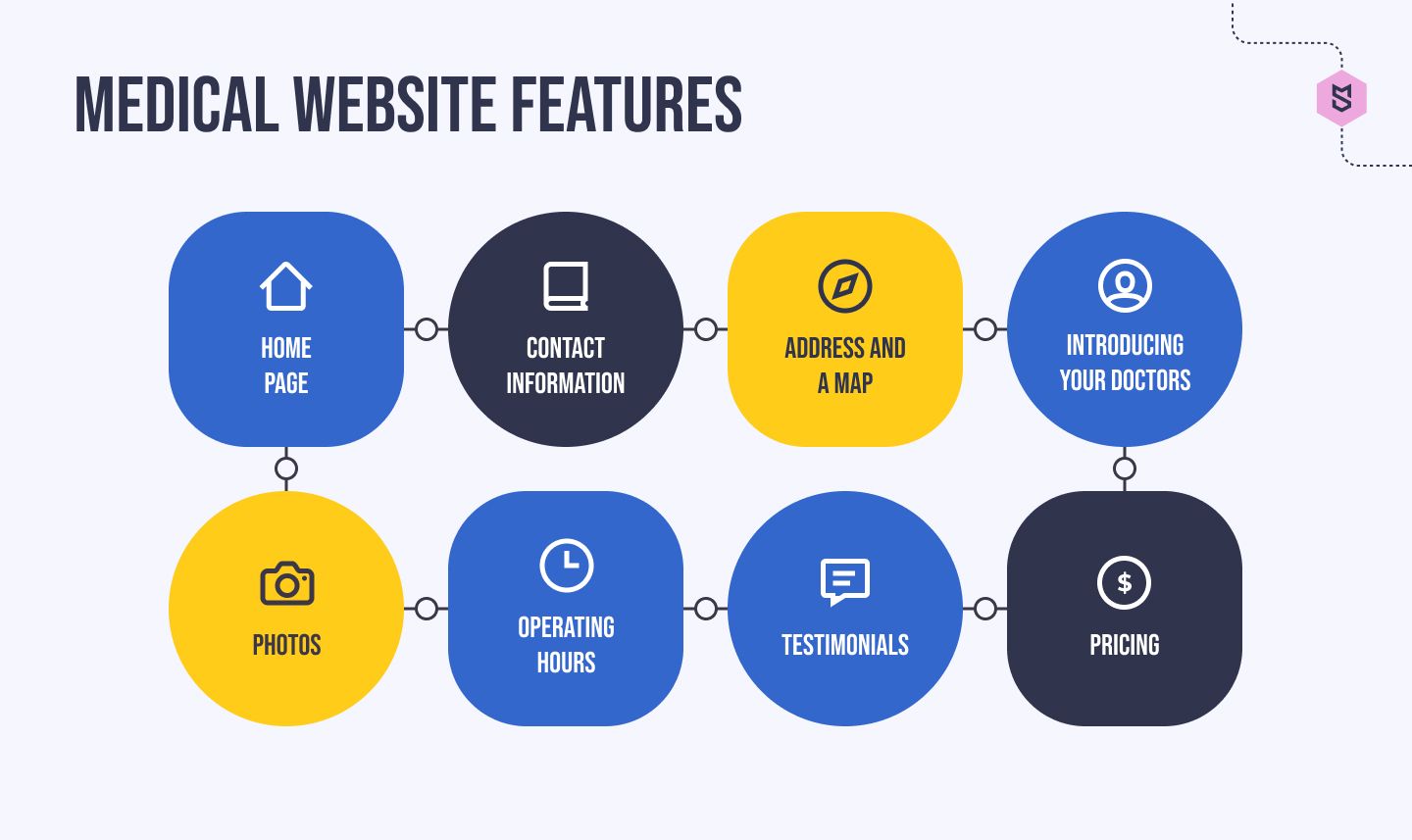
You’ll need certain basic features whether you run a general practice hospital or a specialized clinic.
The most basic option for a clinic website is only a few pages and basically non-existent on-site interactions. Here are the must-have features for a fairly primitive healthcare website:
- Home page. This is where you introduce your facility and highlight everything you need to highlight — the most popular procedures, any events, or information about your highly qualified doctors.
- Contact information. Provide your facility’s phone number, email address, and a contact form.
- Your clinic’s address and a map to your clinic’s location.
- A page introducing your doctors with all their credentials and work experience.
- Photos will make the page — and your website — look more professional and trustworthy.
- Operating hours. If your doctors work different schedules, it will be helpful to provide hours for each doctor.
- Testimonials. As was previously mentioned, most people look up information online when they select a doctor or a clinic. Having favorable reviews on your website might impact potential patients’ decisions.
- Pricing. Your potential patients will want to know how much they’ll pay for your services. It might be beneficial to offer discounts — like for the first visit — or to hold events. However, you need to approach this carefully so as not to appear fickle.
The information listed above can even be implemented on a single scrollable page. It’s also possible to build a single-page application (SPA). In tech speak, an SPA is a website that, instead of reloading whole pages when a user moves between them, rewrites content dynamically on a single page. The content of SPAs reloads faster than that of a traditional website, making this type of website more pleasurable to use for people with slow internet access or limited traffic. This is a great option, well-suited for hospital web development.
If you want a competitive advantage in the medical market, though, you’ll need a more sophisticated website. You’ll need your website to have a patient’s side and a doctor’s side, or an admin panel. In most modern clinics, a designated employee or a team of employees can manage the clinic’s side of the website. These employees can be receptionists or doctor’s assistants. Or they can be doctors themselves.
The following features are beneficial for any modern clinic, according to experienced healthcare web developers.
Personal patient profiles
When a person becomes (or wants to become) your patient, they’ll appreciate the dedicated space where all interactions with your clinic can be stored: all records of a patient’s visits, both previous and planned, issues that brought them to seek medical assistance, sample results, payment history, prescriptions, and more.
Even if yours is a clinic that provides one specific kind of medical help — for example, a dentist’s office — you still offer different procedures and activities.
Having a personal space means your medical practice website development will need to include a signup/login feature. For users’ convenience, you might consider integrating registration via Facebook or Google, but you need to be careful so as not to allow third parties to access your patients’ health information.
Scheduling
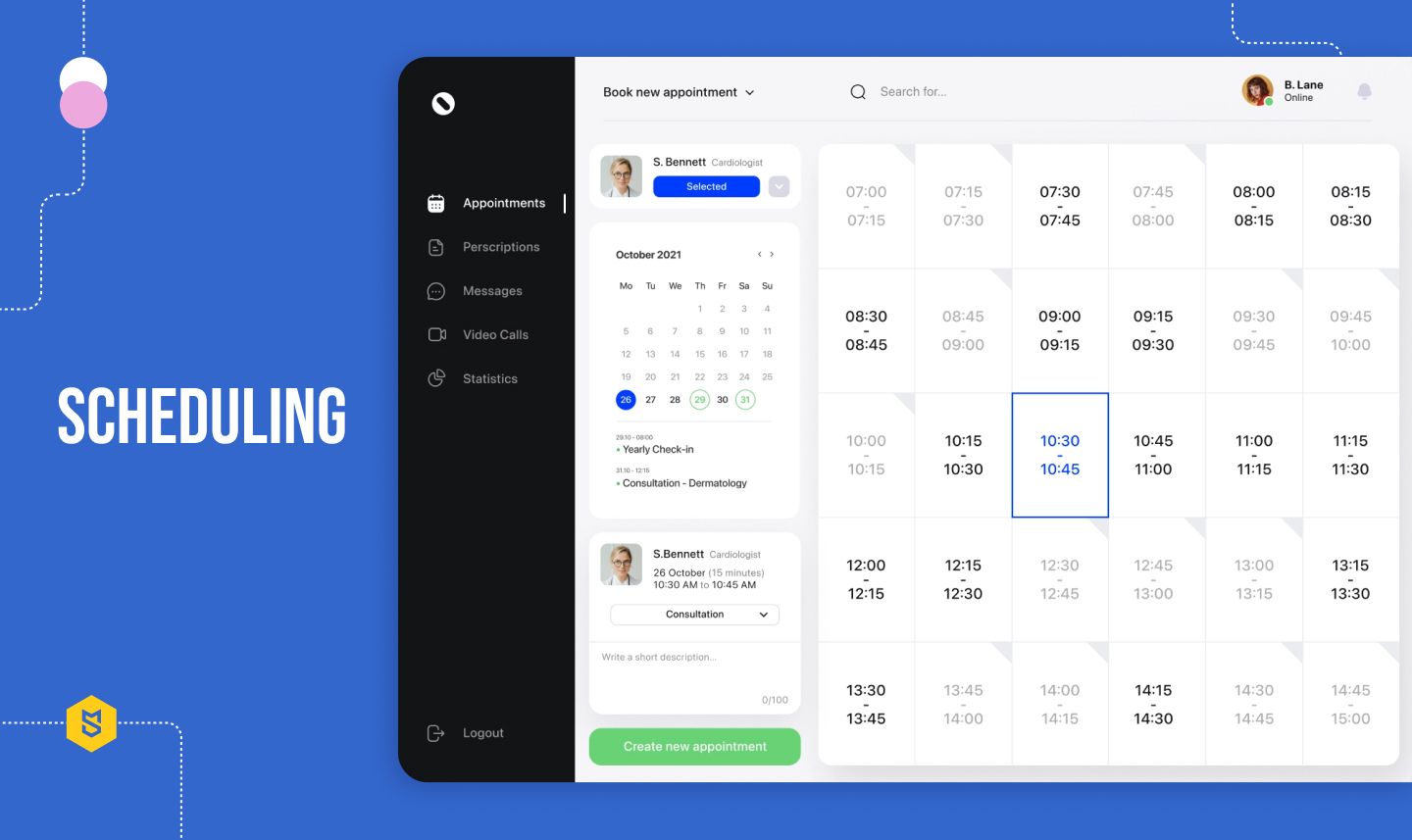
The possibility to schedule an appointment online without any calls is convenient for both patients and doctors. It lessens the work done by receptionists who schedule appointments when patients call or come by the clinic.
To be able to schedule appointments via a website, your medical website developers will need to build an interactive calendar that syncs with servers and updates frequently so as to avoid double bookings.
Notifications
To remind users of appointments, that their blood test results are in, or that their prescriptions are ready for pickup, implement notifications. If you’re building a PWA, push notifications are possible. On a traditional website, you can use notifications in a personal space or an automatically triggered email or text message.
Knowledge base
People look for a doctor when they suspect they or someone they know is sick. To make it easier for users to find doctors, you can create a knowledge base for the ailments you treat. The information in this knowledge base must be true and verified. It can include a general overview, symptoms, treatment methods, and so on. It’s always better for people to learn from a reputable source informed by the World Health Organization and compliant with health-related legislation than from a random person on Instagram who may or may not make things up.
Search
If you’re developing a website for a large hospital, users should be able to search by:
- doctors’ names
- departments
- tests and procedures
- symptoms
- keywords
A smaller specialized clinic — a dentist’s, gynecologist’s, or therapist’s office — will have fewer categories, but there will still be some.
Online video consultations
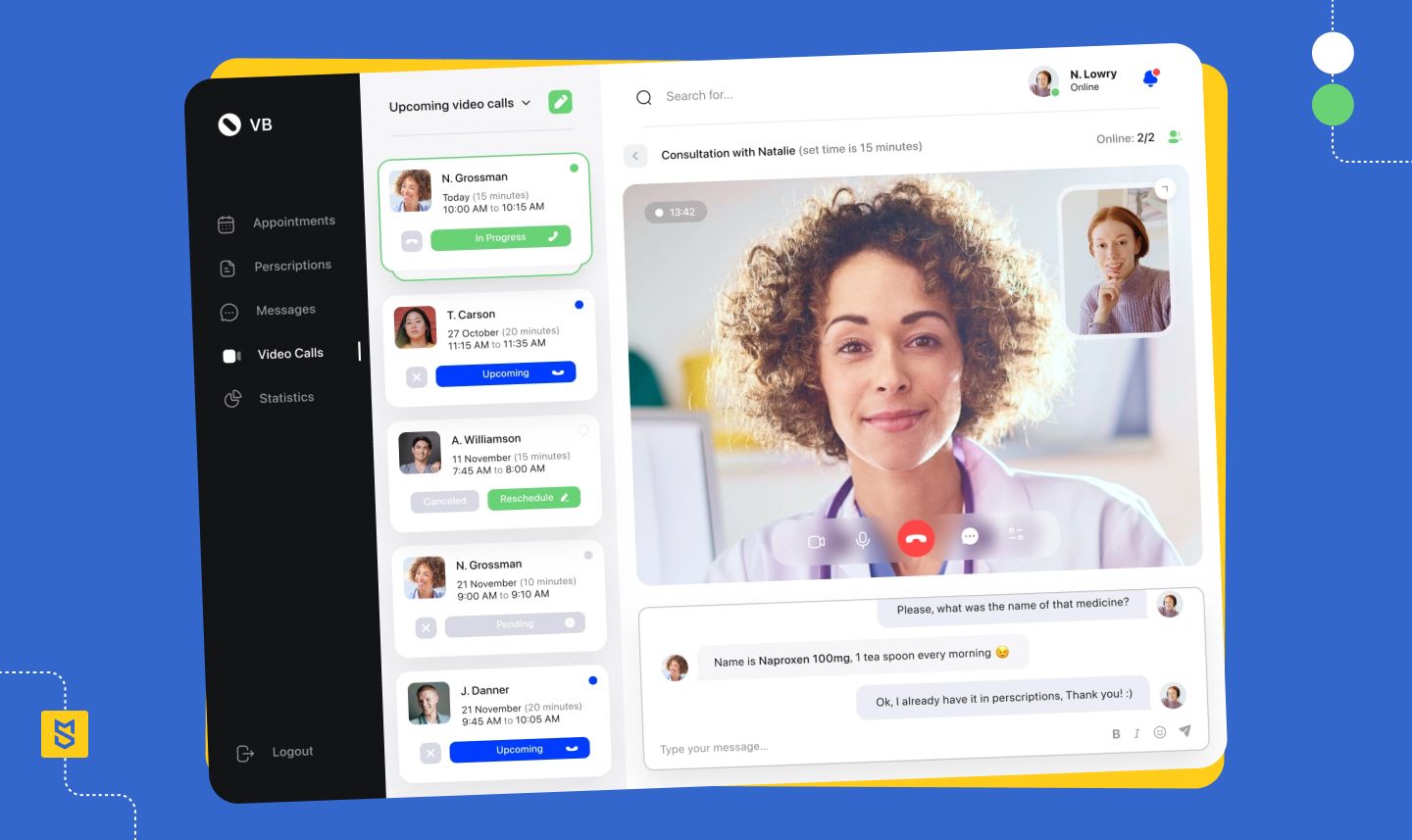
Telemedicine has been on the rise for some time now — it saves time for constantly busy people as well as people with disabilities who may face challenges visiting a hospital. With the COVID-19 outbreak, telemedicine has become the main option for healthcare, since hospitals are overloaded and sometimes quarantined and people are locked down in their homes.
Online consultations can be managed in a number of ways. The best way is to have a video chat option right on the website, but building in this kind of functionality may prove to be a challenge financially and technically. Another option is to integrate a third-party video conferencing service via an API. This is cheaper and faster and will work just as well.
Chat
Chat functionality can be used in addition to (or as an alternative to) video conferencing functionality. An on-site chat with a medical specialist is more convenient than a phone call for many. Besides, a chat can be used by patients for booking appointments and getting prescriptions and by clinics for notifying patients of new appointment times and test results, sending payment reminders, etc.
Online payments
If you’re delivering prescriptions or integrating online consultations into your website — via video, chat, or both — you’ll need to offer your users ways to pay for services without visiting the clinic. For this, you’ll have to integrate a payment gateway. Choosing a payment service is a vital task. Such services have different fees and terms of service, and your medical web design company can conduct research and offer you various options.
Admin panel
Your website will need to be managed on the clinic side. Designated employees — assistants or receptionists — will need to check and update schedules, and send patients any relevant information like test results. Admins should also be able to add and remove doctors and other employees.
The design for an admin panel is usually much simpler than the design for a client-side website. There’s little need to make an admin panel look fancy. It’s much more important to have a functional and efficient user experience than a beautiful interface.
Search engine optimization
A big part of any website’s success is quality search engine optimization, or SEO. That’s another reason to have a knowledge base, by the way. Relevant information laid out by professionals employing current SEO best practices will elevate your website in Google rankings, increasing the frequency with which your site appears in search results. More frequent appearances in search results will mean more people will see your website. Some of them will open the page, and some will even decide to visit your clinic. That is, if your website looks great and is up-to-date.
The best medical web examples in market
To show you what we’re talking about when we say “good medical website design”, here are some examples from all over the web.
Integrated Podiatry Clinic
This Australian clinic that specializes on feet health offers one of the cleanest and neatest web designs we’ve seen. It doesn’t have an abundance of information on its home page but instead instills the feeling of comfort with its muted tones and large fonts. That’s what many patients seek when opening a medical platform.
Collective Health
Collective Health is a TPA + navigation and advocacy solution in the medical industry, helping medium and large companies to process employee claims. The platform’s website is visually simple, with ample white space. It looks quite elegant. However, the best thing about Collective Health website is its uncluttered layout that allows for clear delivery of the message.
Finally, the option to try the platform via a demo is a great way to attract new customers.
Carson Tahoe Health
Two of the top features this regional healthcare system offers are its soothingly muted color scheme and easy navigation. With all important features right there at the top of the home page, the platform is very intuitive and user-friendly. Big noticeable icons for the most popular features after some scrolling add to this effect as well.
How to choose a medical website design company [Checklist]
Now that you know the approximate scope of features and the tech stack to build a medical website, let’s talk a bit about choosing a healthcare web development partner. What should you take into consideration to choose a company that will help you achieve success?
Have your medical website idea fleshed out
When you go looking for healthcare website developers, the process of finding the best fit will become significantly easier if you have your idea worked out in as much detail as possible.
It doesn’t necessarily need to be a well-made mockup or even a drawing. Even if it’s just a written description, try to add as many of your thoughts to it as you can. This way, when you approach companies for help in web development for healthcare, you’ll be able to quickly describe your idea to them. Medical website developers with experience will be able to assess the necessary time and specialists faster with a full description.
Set your budget
When choosing a partner, it’s vital that you know how much you can invest into development. The cost is among the most important parameters in choosing developers for your project.
Your possible investment will affect, among other things, the area you might need to search for contractors as in different parts of the world, the developers’ hourly rates differ.
The US tends to be the most expensive place to hire a team, followed by Western European countries, Israel, Canada, Australia. Countries like Brazil, India, the Philippines are believed to be among the cheapest when it comes to development. In the middle sit East European countries Ukraine and Poland.
Select an area to hire developers from
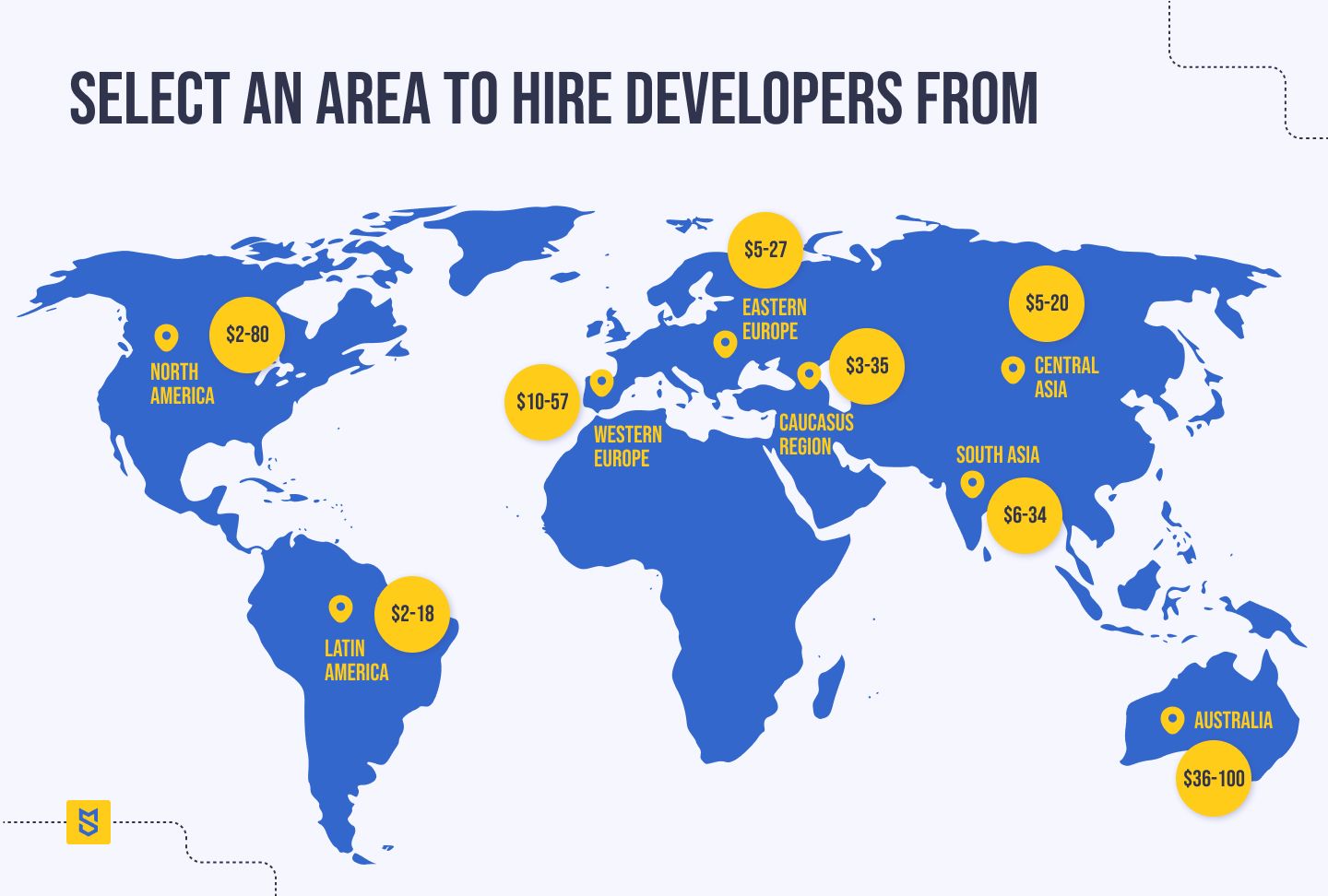
There is more to choosing a team from a certain country than the cost of their labor, so don’t be in too much haste just because of the price. You’ll also have to consider the following factors:
- Language barriers
- Time difference
- Cultural fit
While most developers all around the world speak English at an acceptable level for work communication, the time difference between you and your selected team will play a significant role in quality communication.
It’s usually recommended that the time difference between teammates and the team and client doesn’t exceed 9 hours — the length of a typical workday. This way, your and your team’s work schedules will definitely overlap at some point.
Cultural differences also shouldn’t be overlooked as they might hinder your communication with the team on a whole different level: the many cultures around the world sometimes have different approaches to work processes and can also view ideas differently. It’s not an impossible obstacle to overcome, but keep it in mind.
Make a cursory check of multiple companies
Platforms like Clutch and GoodFirms offer a wealth of information on companies that can undertake projects of website development for doctors. Clutch even has sophisticated filtering systems to make the selection process smoother.
Check as many companies as you can in your chosen area. Filter them by your niche, budget, technology you’d prefer used, etc. Skim over client reviews, ratings, check previous projects. Consider contacting previous clients of the companies you like. This work will allow you to make a shortlist of sorts.
It’s usually recommended to shorten the list of candidates to up to five companies that seem to be the best fit for your project.
Contact all companies in your shortlist
To choose the best team, you need to compare several companies. Contact all the companies on your list for a consultation. Most outsourcing companies today are willing to offer a simple service free of charge to show their strengths to potential clients. It can be a simple design or some amount of research. You can compare the results between medical website development firms to choose the best one.
Sign the contract
Don’t forego making things official and negotiating the terms of your agreement. Healthcare website development for doctors requires a significant investment of time and money — especially money — and you need to be sure that the terms of the partnership are mutually beneficial.
With the contract signed, the work can finally begin.
Bonus: Infographic on how to develop a healthcare website
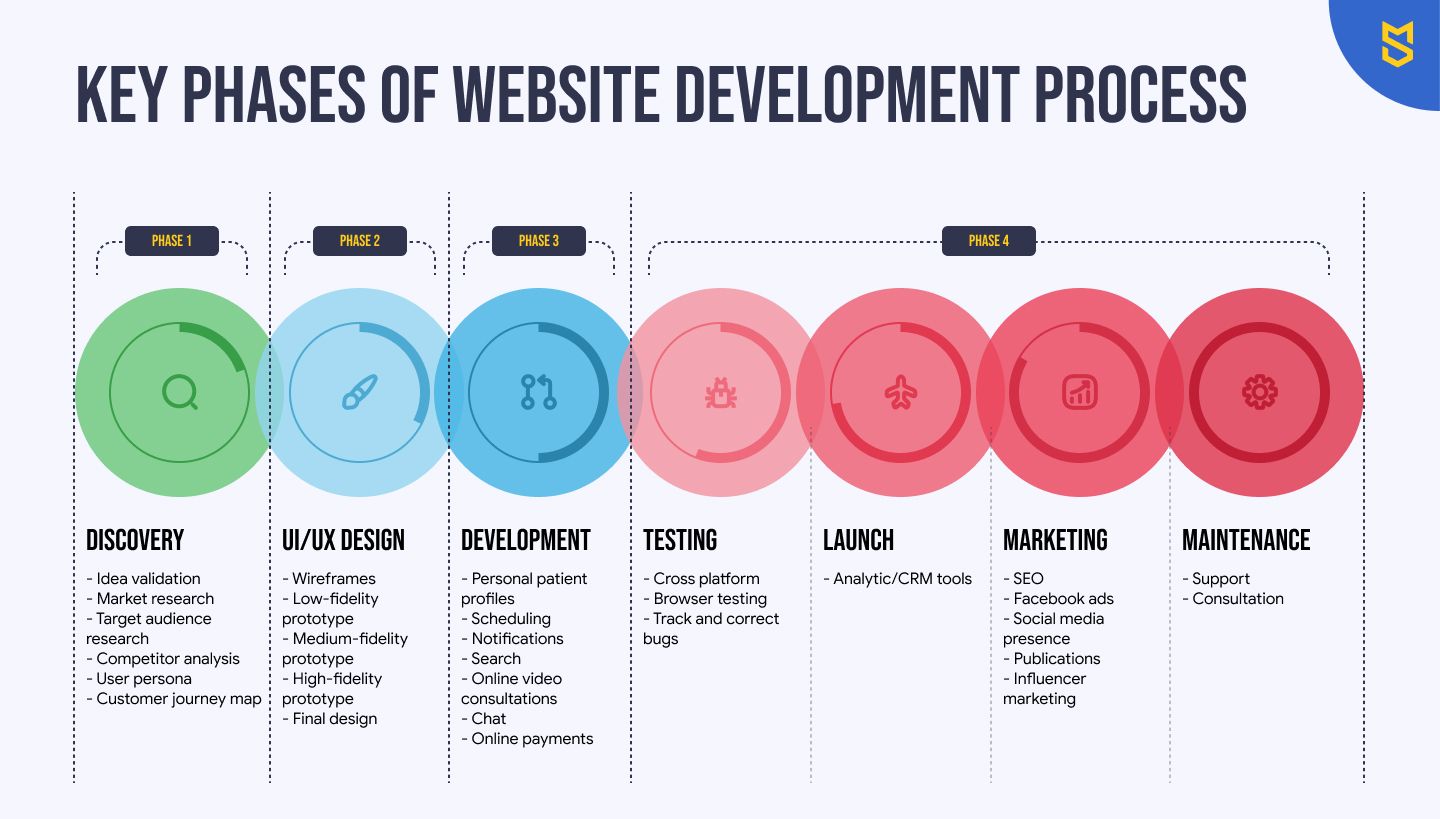
Cost to build a medical website
To estimate the precise cost for medical clinic website development, you’ll need to know exactly what features you need, decide on the design, and choose an outsourcing web development company. Rates differ from company to company.
Here, we can offer you a very approximate estimate based on the features we’ve listed above and our own design and development rates.
| Stage | Time, h | Cost, USD |
|---|---|---|
| Project management | 320–400 | 14,400–18,000 |
| Discovery/Idea validation | 80–100 | 3,600–4,500 |
| Market research | 32–64 | 1,440–2,880 | UI/UX design | 160–240 | 7,200–10,800 |
| Front-end development | 800–960 | 36,000–43,200 |
| Backend development | 640–800 | 28,800–36,000 |
| Testing | 400–480 | 18,000–21,600 |
| TOTAL | 2432–3044 | 109,440–136,980 |
Developing a website for a medical institution will require the following healthcare web development team:
- 1 project manager
- 1 web designer
- 1 frontend developer
- 1 backend developer
- 1 quality assurance specialist
With one of each type of professional, it will take about 5 to 7 months to create a hospital website. The cost of development can start from $109,440. If you’d like to speed up development, you can hire more than one designer, frontend/backend developer, or QA specialist. The medical website design cost will increase under these conditions, of course.
If you’re on a budget, you can skip the features you think can wait and implement them later. We do recommend researching whether features are really necessary beforehand, however. While the medical industry is only at the start of its path to digitization, your competitors are gearing up as well. Proper research will help you prioritize features to implement.
Mind Studios experience in medical web development
Healthcare is one of the industries we at Mind Studios work the most with and consider ourselves well-versed in.
Among all our medical projects one stands out, and it’s a web-based project. It’s a system aimed to automate symptom collection from patients pre-visit, which will speed up and simplify doctor visits for patients and healthcare professionals alike.
This is the second project we’re working on with this client as we’ve managed to earn their trust with the first one.
Among top features we’ve built for this web medical product, we’d like to highlight its HIPAA compliance and dynamic body images to make it easier for patients to show where the pain is they’re suffering from. We’re currently working on creating an NLP-enabled chatbot for it as well.
Conclusion
A website is a must to make it in today’s competitive market. And with the medical industry being somewhat late at going all-digital, now might be the best time to jump at the opportunity to get ahead.
We’ve laid out the results of our industry research in this article. This is general information to help you set your direction. If you have any unanswered questions or need additional information from medical web developers, you can request a consultation.

